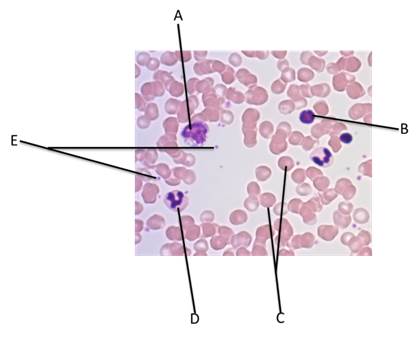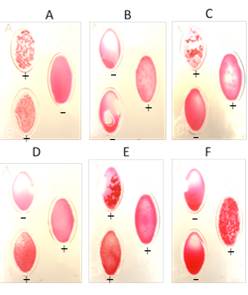Review Exercise Lab 1 – Blood PDF
Name _________________________________________________________________________________________
Review Exercise Lab 1 – Blood
Complete the following questions.
1. Function and Component of Blood.
Select the word from the list below which best pertains to each statement below. Words must not be used more than once. Write the word next to the statement.
Defense transport homeostasis plasma formed elements
Serum myeloid lymphoid hematopoietic connective
1. _____________ Stem cells producing all granulocytes.
2. _____________ The fluid component of blood.
3. _____________ Ability to protect us from microbial invasion.
4. _____________ Blood is an example of this tissue type.
5. _____________ The liquid component after blood clots.
6. _____________ These stem cells produce B and T cells.
7. _____________ Ability to keep the body temperature constant.
8. _____________ The stem cell which leads to all blood cells.
9. _____________ The cellular component of blood.
10. _____________ Distributes material all over the body.
2. Blood Cells
1. Describe the basic structure of hemoglobin.
____________________________________________________________________________________
____________________________________________________________________________________
2. How many oxygen molecules can one hemoglobin carry, and what is require for oxygen to bind to hemoglobin?
____________________________________________________________________________________
3. Aplastic anemia is a rare disorder where the body does not make sufficient blood cells. During this condition which part of the body would be the source of this problem? Why?
____________________________________________________________________________________
4. Describe the shape and hemoglobin content of a normal RBC.
____________________________________________________________________________________
____________________________________________________________________________________
5. Distinguish granulocytes from agranulocytes. Be sure to name the WBCs making up each group.
____________________________________________________________________________________
____________________________________________________________________________________
6. Why are plates not considered to be cells?
____________________________________________________________________________________
7. What infection or disease is associate with each of the following?
a) High levels of neutrophils ________________________________
b) High levels of eosinophils ________________________________
c) Abnormally high WBC count ________________________________
d) Abnormally high platelet count ________________________________
e) Abnormally low WBC count ________________________________
f) Abnormally low platelet count. ________________________________
2.2 Examine the figure to the right and identify the labeled cells.
1. A ________________
2. B ________________
3. C ________________
4. D ________________
2.3 Match each test with its respective description. Write the letter of the test next to the description.
1. Hematocrit ________ total amount of albumin in plasma
2. Bleeding time ________ compatibility of blood
3. Blood typing ________ Anemic condition
4. Plasma protein test ________ Percentage of Neutrophils in blood
5. Differential WBC count ________ how long it takes to stop bleeding.
3. Tests Using Blood and Blood Components
A patient is suspected to be aplastic anemic. He has a fever, he gets tired very fast, suffers from shortness of breath, complains of dizziness, and skin looks very pale. If he is lacking blood he may have to get a blood transplant. Infection must be ruled out. Which of the following test may be required? Circle the ones that may be required.
Hematocrit Bleeding time Coagulation time Plasma protein test
Thrombin test Blood typing Hemoglobin concentration Dif. WBC count
4. Blood typing
Examining the figure to the right and provide responses as requested below. (Positives (+) indicate clumping and negatives (-) indicate no clumping).
For Each panel, give the following ;
-
- Blood type
- Type of antigen present
- Type of blood antibody present
- Presence or absence of Rh factor
- Which blood type CANNOT receive blood from this blood type?
- which blood type CANNOT donate blood to this blood type?
5. Blood Disorders3
Use your text or the internet give a short description of the various types of blood disorders.
1. Sickle cell anemia ___________________________________________________________
2. Aplastic anemia ___________________________________________________________
3. Hemolytic anemia ___________________________________________________________
4. Thalassemia __________________________________________________________
5. Vitamin deficiency anemia ___________________________________________________________
6. Leukemia ___________________________________________________________
7. Lymphoma ___________________________________________________________
8. Thrombocytopenia ___________________________________________________________
9. Leukocytosis ___________________________________________________________
10. Leukopenia ___________________________________________________________
6. Research
Select a blood disorder and write a short essay. be sure to include information such as what the disorder is, what causes it, common signs and symptoms, treatment, and other relevant information. Be sure to cite the source of your information. Use the APA or MLA format. Include the source used.





